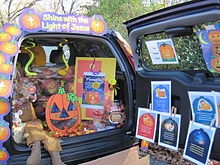Trunk-or-treating

Trunk-or-treating is a form of Halloween tradition which often serves as an alternative to trick-or-treating in the United States and Canada. Beginning in the 1990s, it usually involves candy or other treats being handed out of or taken from the trunks of vehicles, typically on Halloween night, although this tradition is also held in the days preceding the annual celebration on October 31. It is intended to be a safer alternative to trick-or-treating as a result of poisoned candy myths.
History
[edit]
This annual tradition was begun in the 1990s by church organizations and its associated groups as a "fall festival" for an alternative to trick-or-treating in churches, and was also created as a result of "discomfort with some of Halloween's themes".[note 1][1][2][3] While trick-or-treating involves going to homes or buildings to receive candy, trunk-or-treating is associated with candy being handed out or served from the trunks of vehicles.[4][2][3] Additionally, trunk-or-treating avoids street crime or car danger that may be associated with normal trick-or-treating.[5]
The etiquette of trunk-or-treating has led to the tradition also being called "Halloween tailgating", after the practice of handing out or serving candy from the trunks of vehicles.[6][7] Trunk-or-treating has become increasingly popular in the 21st century since originating from Center Point, Alabama, where the first such event was initially held.[2][6] Some churches and church leaders have attempted to connect with the cultural phenomenon of Halloween, viewing it as an opportunity for cultural engagement with the Gospel.[8] Others have called for more city or community group-sponsored trunk-or-treats, so they can be more inclusive.[9]
Etiquette
[edit]Trunk-or-treating is typically held on Halloween and Halloween night, although it can also be hosted in the days before the annual celebration.[10] Trunk-or-treat locations vary, although they are often held at churches or schools, in large parking lots, or at car dealerships.[2][6] The vehicles that candy is collected from are also usually covered with Halloween decorations.[10][11]
Notes
[edit]- ^ Sources are unclear on when the tradition began. While NPR reports that it began in 1994 in Alabama, this is the only source that mentions the specific year. Other sources, including the HuffPost, state the late 1990s. Therefore, only 1990s is noted as a result of the various reporting on the initial date(s) of when the tradition began.
References
[edit]- ^ Lecci, Stephanie (October 31, 2013). "A New Way to Do Halloween: Chocolate Chunks in the Trunk". Morning Edition. NPR. Retrieved June 29, 2024.
- ^ a b c d Archie, Ayana (October 31, 2023). "What to know about trunk-or-treating, a trick-or-treating alternative". NPR. Retrieved October 18, 2024.
- ^ a b Costanzo, Roslyn (September 19, 2016). "'Trunk Or Treat' Is Changing Halloween As We Know It". HuffPost. Retrieved October 18, 2024.
- ^ "Halloween Safety: A National Survey of Parents' Knowledge, Attitudes, and Behaviors" (PDF). Safe Kids Worldwide. October 2011. Retrieved October 18, 2024.
- ^ Lopez, Lindsey Hunter (October 31, 2023). "Why 'Trunk-or-Treat' Is a Hard Pass for My Family". SheKnows. Retrieved October 19, 2024.
- ^ a b c Santos, Fernanda (October 31, 2006). "Santos, Fernanda. "Trunk or Treat! Halloween Tailgating Grows"". The New York Times.
- ^ Wethington, Paula (October 1, 2022). "Trunk-or-treat: Taking a look at the alternative Halloween trend". Detroit Free Press. Retrieved October 18, 2024.
- ^ Stetler II, Darrell (August 22, 2023). "Trunk or Treat Planning for Churches: A Step-by-Step Guide". NewStart Discipleship Resources, LLC. Retrieved June 28, 2024.
- ^ "'Trunk or treat' doesn't include all children", Standard Examiner, October 11, 2010 Archived December 9, 2014, at the Wayback Machine
- ^ a b Milbrand, Lisa (September 30, 2024). "Everything You Want to Know About Trunk-or-Treat". Real Simple. Retrieved October 18, 2024.
- ^ Davison, Candace Braun (September 15, 2023). "Fewer People Are Trick-or-Treating These Days—And Opting For This New Trend Instead". Delish. Retrieved October 19, 2024.
